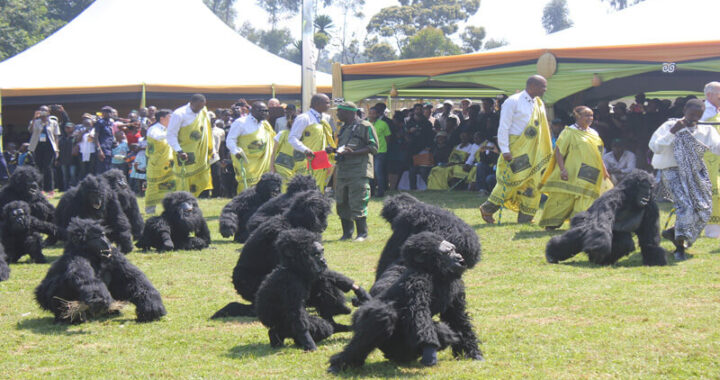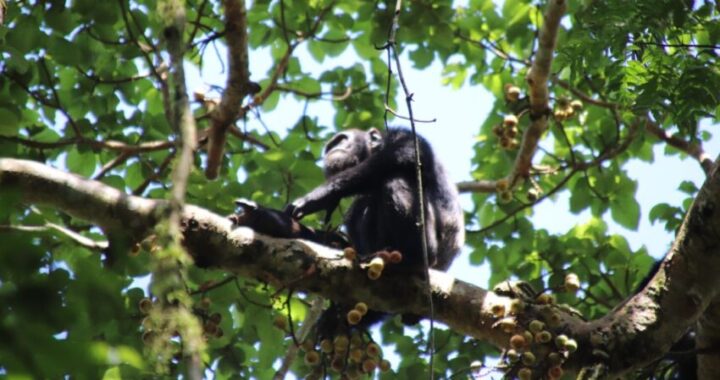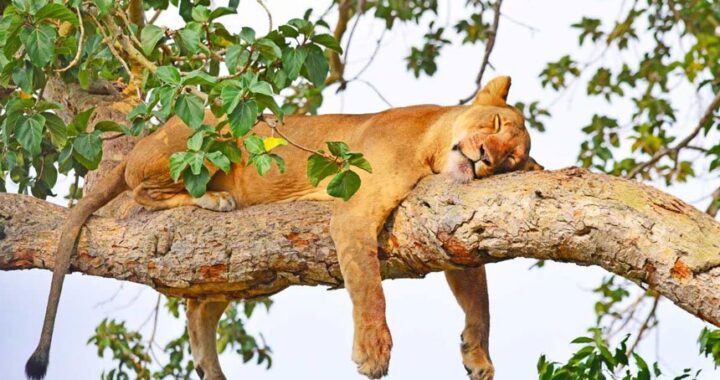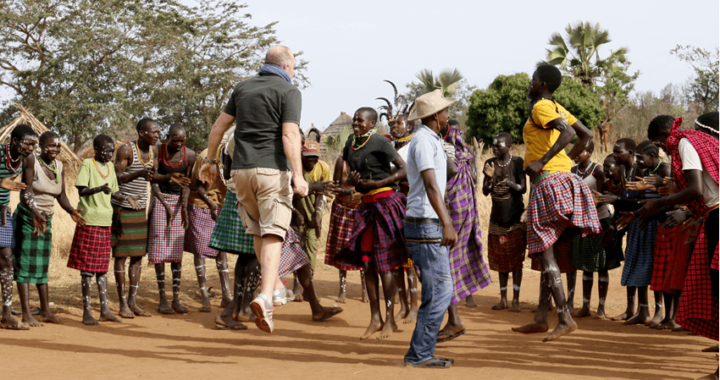Kwita Izina is translated as “naming ceremony” in English and refers to the ancient African tradition of naming children in Rwanda. The gorilla naming ceremony was particularly inspired by this practice with the hope to raise awareness of mountain gorillas and endangered species in Volcanoes national park by encouraging locals and international visitors to support conservation efforts.
Kwita Izina
Kwita Izina is also celebrated to honor the work done to protect flora and fauna by key stakeholders including rangers, gorilla doctors, conservationists, tour guides, and local communities. The event is organized by the umbrella organization Rwanda Development Board (RDB) in collaboration with the government. Other partners include the gorilla authorities in Uganda and DR Congo that share the Virunga conservation area. The official first edition of Kwita Izina was launched in 2005.
According to Visit Rwanda official website the total number of gorillas born and named in Volcanoes national park since is 397. The event is more than just naming gorillas and has been gaining momentum every year. Kwita Izina features a wide range of events including conservation exhibition, business conference, and diner, music and dance performances, launch of several community development projects, and familiarization trips for the invited guests that name the gorillas as well as media and travel influencers. Over 20,000 people attend a week-long event held every year in September in Kinigi village outside the park. Kwita Izina is becoming one of the largest conservation events in the world. Opportunities for those intending to participate and visit the park are available for booking through RDB or a tour operator.
Impact of Kwita Izina
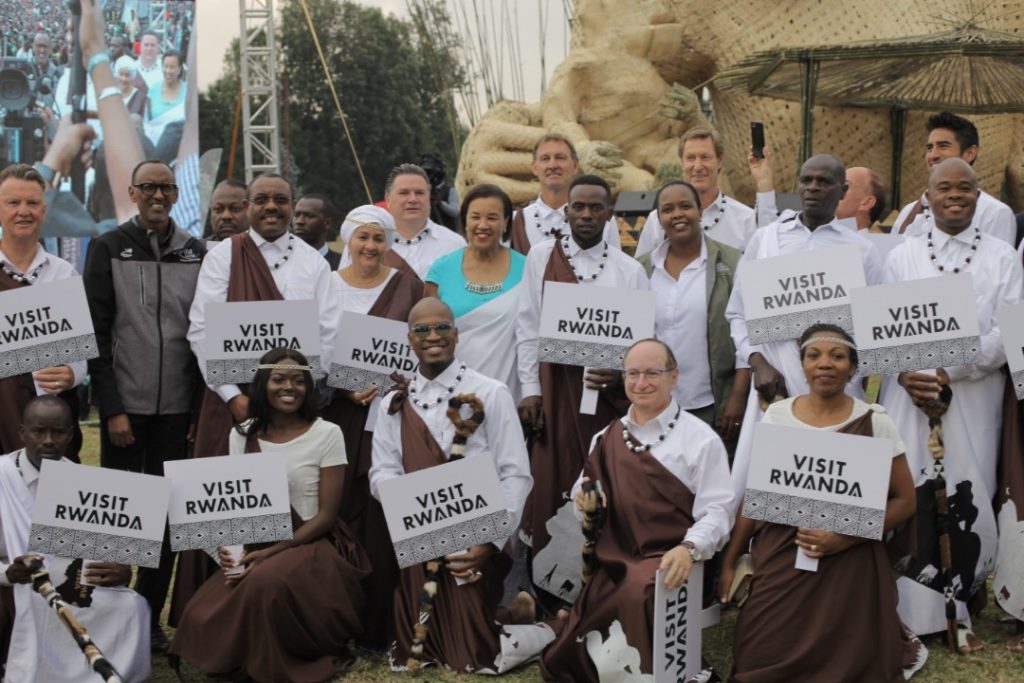
The increasing popularity of Kwita Izina revolves around the contribution of gorilla tourism to local economic development. Local communities around Volcanoes national park rely heavily on tourism. According to RDB the amount of revenue generated from gorilla trekking safaris totaled to $ 113 million in 2022. The industry also supports over 39,000 people including private tour operators, hotels, and farmers. Revenue sharing scheme was introduced in 2005 and with 10% of the revenue committed to empowering the local communities around the park.
The purpose was to tackle the problem of over dependence on natural resources through poaching for bushmeat by setting snare wires to trap small antelope species. Snares would sometimes injure or kill gorillas. People also used to obtain food, medicinal plants, water, firewood, and building materials from the forest. The swamps on the peaks of Bisoke, Gahinga, and Muhabura are a source of papyrus and other weaving materials.
Much of the land at foothills of Volcanoes national park is terraced farmlands where people produce crops such as beans, Irish and sweet potatoes, maize, green tea, and pyrethrum (for export to Europe). These human activities affect the natural habitat and constitute the main threats to the survival of gorillas. According to Dian Fossey Gorilla Fund International, the population of gorillas in Virunga area was less than 200 in the 1980s. The primates were on the verge of extinction thanks to the benefits of gorilla tourism.
The problem of overdependency on nature was tackled through introducing alternative sources of livelihood using the revenues earned from gorilla safaris. For instance, the Gorilla Guardians Village formerly Iby’Iwacu cultural village was formed in 2005 to support ex-poachers through handicraft making, cultural tourism, bee, and goat keeping. The village offers an opportunity to experience Rwandan traditional culture including dance performances. There has also been extensive investment in public infrastructure development including building schools, health care and clean water facilities and roads.
There’s also education and awareness in the community about the importance of gorillas and wildlife. The park and the accommodations in and around provide jobs to many people from the local communities. People were able to earn income and depend less on nature. Eventually there was less poaching and encroachment which paved the way for conservation.
In addition to supporting the livelihoods, gorilla tourism revenue is also invested in security of the park and conservation strategies including anti-poaching patrols, research, and monitoring. For instance, on a daily basis rangers monitor the movement of gorillas, remove snare wires if found, and also report to the team of gorilla doctors who intervene to treat injured or sick gorillas.
Status of mountain gorillas
Active conservation was introduced by Dian Fossey who established Karisoke Research Center in the park in 1967. This program has successfully controlled threats to gorillas in Rwanda, Uganda, and DR Congo. The census of mountain gorillas in 2018 indicates that their numbers increase to 1,003 individuals of which 604 are in the Virunga Area. Over 459 gorillas, which is almost half of the world’s gorilla population, are found in Uganda’s Bwindi Impenetrable forest national park. Overall, gorillas have come back from the verge of extinction.
The International Union for Conservation of Nature updated the status of gorillas from being critically endangered to endangered species in 2018. Therefore, Kwita Izina is a celebration of this achievement particularly in Rwanda. The event also acts as a platform for fundraising resources to strengthen public-private collaboration for a common goal. Rwandans are involved in naming the gorillas which instills a spirit of conservation.
The international celebrities that participate in naming of gorillas too also help to strengthen the image of Rwanda on the international scene. For instance, Sir David Attenborough named a baby gorilla called Inshungu in 2016 and revealed how conservationists have helped to save the apes from extinction. However, any disruption to gorilla safaris can be detrimental to the local economy. For instance, during the Covid-19 pandemic the park was closed and there was a reduction in the revenue stream.
According to the International Gorilla Conservation Program, gorillas are vulnerable to coronavirus. Given that the primates shared over 98% of their DNA with humans. It has been determined that diseases can be transmitted by the people that come into close contact with the mountain gorillas including caretakers, tourists, trackers, researchers, rangers, guides, porters, poachers and local communities.
The Non-Human Primate Covid-19 Information Hub released a concern that if a novel virus like SARS CoV-2 starts circulating in the great ape populations and causes significant and widespread disease, the impact could be severe, contributing to local or subspecies extinction since mountain gorillas exist in small, vulnerable populations. There are guidelines in place to safeguard gorillas from covid-19 including the gorilla trekking rules and regulations.

